Report on Economic Growth in Australian Agricultural Export Sector
VerifiedAdded on 2023/06/13
|7
|1542
|479
Report
AI Summary
This report provides an economic analysis of the growth in the Australian agricultural sector, particularly focusing on its export market. It evaluates a newspaper article highlighting the sector's record-breaking performance due to favorable climatic conditions and livestock industry performance. The report identifies key stakeholders, including farmers, consumers, and the nation as a whole, who benefit from this growth. It employs a supply and demand framework to illustrate the market dynamics and the impact of increased output on prices and social welfare. Furthermore, the report offers recommendations for sustaining growth, such as mitigating the impact of climate change, enhancing farmer productivity through vocational training, increasing foreign exposure, and diversifying the customer base to reduce reliance on the Asian market. The analysis concludes that while the agricultural sector's growth is promising, addressing its dependence on climatic conditions and market concentration is crucial for long-term sustainability. Desklib provides access to this and many other solved assignments for students.
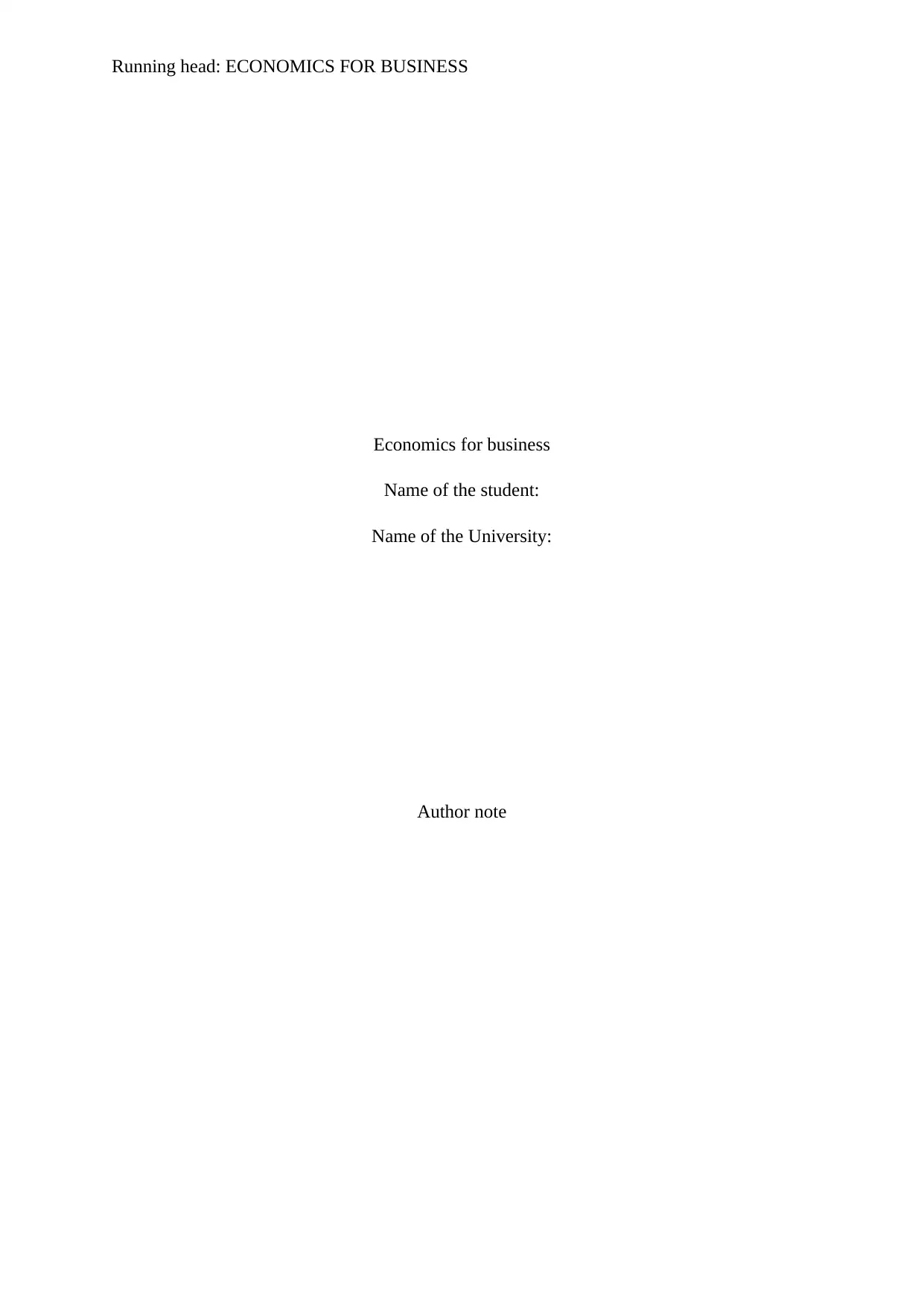
Running head: ECONOMICS FOR BUSINESS
Economics for business
Name of the student:
Name of the University:
Author note
Economics for business
Name of the student:
Name of the University:
Author note
Paraphrase This Document
Need a fresh take? Get an instant paraphrase of this document with our AI Paraphraser
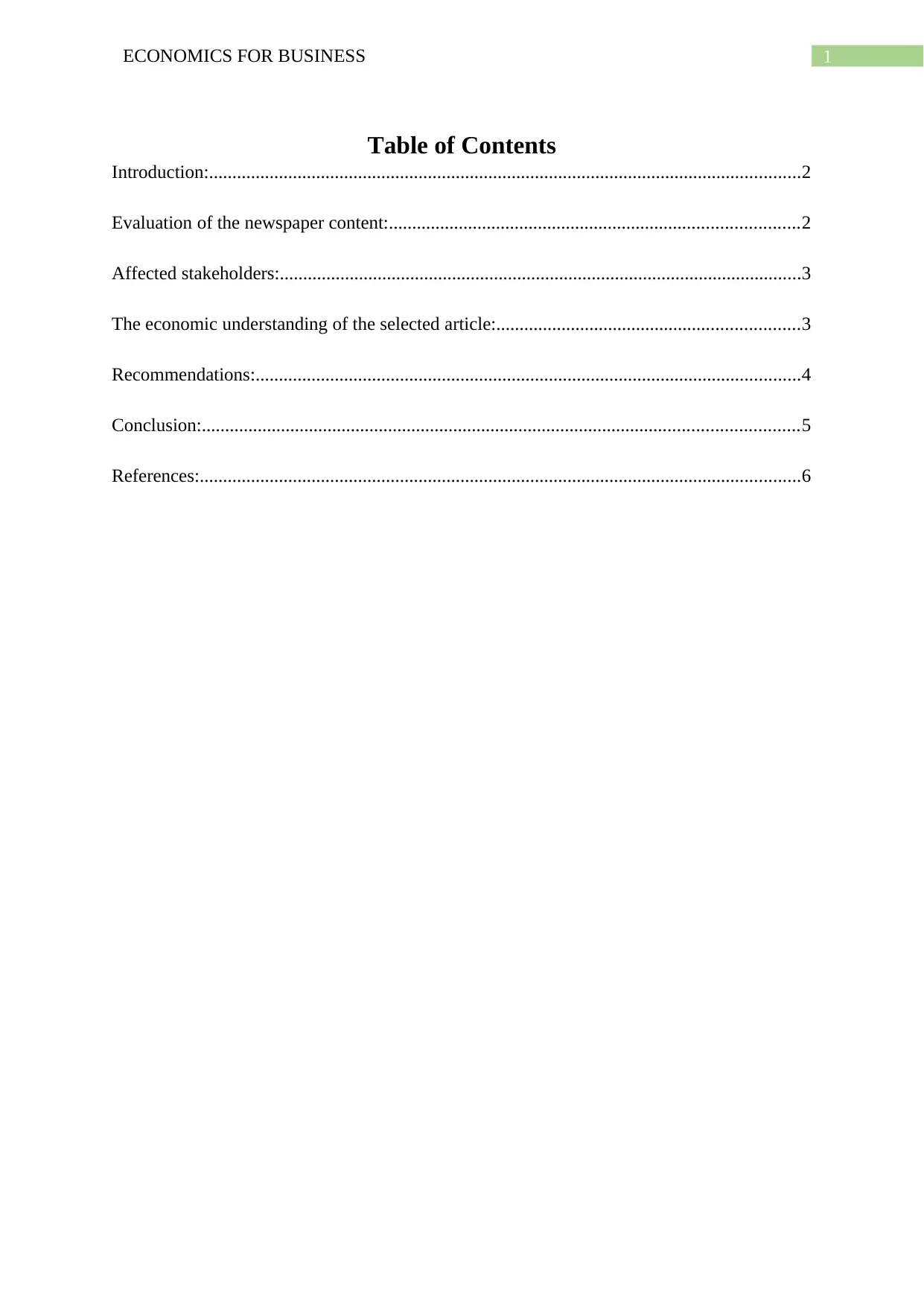
1ECONOMICS FOR BUSINESS
Table of Contents
Introduction:...............................................................................................................................2
Evaluation of the newspaper content:........................................................................................2
Affected stakeholders:................................................................................................................3
The economic understanding of the selected article:.................................................................3
Recommendations:.....................................................................................................................4
Conclusion:................................................................................................................................5
References:.................................................................................................................................6
Table of Contents
Introduction:...............................................................................................................................2
Evaluation of the newspaper content:........................................................................................2
Affected stakeholders:................................................................................................................3
The economic understanding of the selected article:.................................................................3
Recommendations:.....................................................................................................................4
Conclusion:................................................................................................................................5
References:.................................................................................................................................6
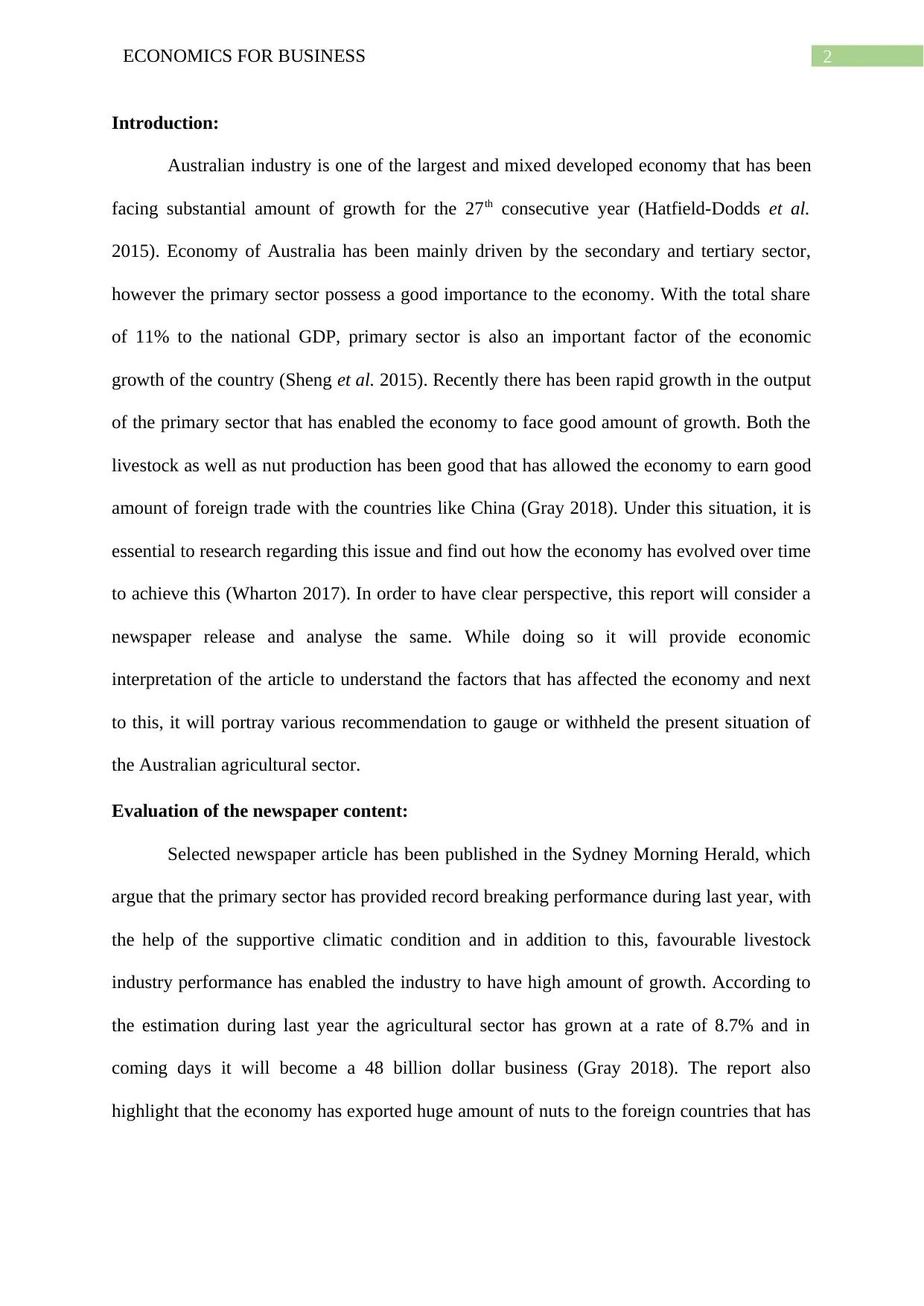
2ECONOMICS FOR BUSINESS
Introduction:
Australian industry is one of the largest and mixed developed economy that has been
facing substantial amount of growth for the 27th consecutive year (Hatfield-Dodds et al.
2015). Economy of Australia has been mainly driven by the secondary and tertiary sector,
however the primary sector possess a good importance to the economy. With the total share
of 11% to the national GDP, primary sector is also an important factor of the economic
growth of the country (Sheng et al. 2015). Recently there has been rapid growth in the output
of the primary sector that has enabled the economy to face good amount of growth. Both the
livestock as well as nut production has been good that has allowed the economy to earn good
amount of foreign trade with the countries like China (Gray 2018). Under this situation, it is
essential to research regarding this issue and find out how the economy has evolved over time
to achieve this (Wharton 2017). In order to have clear perspective, this report will consider a
newspaper release and analyse the same. While doing so it will provide economic
interpretation of the article to understand the factors that has affected the economy and next
to this, it will portray various recommendation to gauge or withheld the present situation of
the Australian agricultural sector.
Evaluation of the newspaper content:
Selected newspaper article has been published in the Sydney Morning Herald, which
argue that the primary sector has provided record breaking performance during last year, with
the help of the supportive climatic condition and in addition to this, favourable livestock
industry performance has enabled the industry to have high amount of growth. According to
the estimation during last year the agricultural sector has grown at a rate of 8.7% and in
coming days it will become a 48 billion dollar business (Gray 2018). The report also
highlight that the economy has exported huge amount of nuts to the foreign countries that has
Introduction:
Australian industry is one of the largest and mixed developed economy that has been
facing substantial amount of growth for the 27th consecutive year (Hatfield-Dodds et al.
2015). Economy of Australia has been mainly driven by the secondary and tertiary sector,
however the primary sector possess a good importance to the economy. With the total share
of 11% to the national GDP, primary sector is also an important factor of the economic
growth of the country (Sheng et al. 2015). Recently there has been rapid growth in the output
of the primary sector that has enabled the economy to face good amount of growth. Both the
livestock as well as nut production has been good that has allowed the economy to earn good
amount of foreign trade with the countries like China (Gray 2018). Under this situation, it is
essential to research regarding this issue and find out how the economy has evolved over time
to achieve this (Wharton 2017). In order to have clear perspective, this report will consider a
newspaper release and analyse the same. While doing so it will provide economic
interpretation of the article to understand the factors that has affected the economy and next
to this, it will portray various recommendation to gauge or withheld the present situation of
the Australian agricultural sector.
Evaluation of the newspaper content:
Selected newspaper article has been published in the Sydney Morning Herald, which
argue that the primary sector has provided record breaking performance during last year, with
the help of the supportive climatic condition and in addition to this, favourable livestock
industry performance has enabled the industry to have high amount of growth. According to
the estimation during last year the agricultural sector has grown at a rate of 8.7% and in
coming days it will become a 48 billion dollar business (Gray 2018). The report also
highlight that the economy has exported huge amount of nuts to the foreign countries that has
⊘ This is a preview!⊘
Do you want full access?
Subscribe today to unlock all pages.

Trusted by 1+ million students worldwide
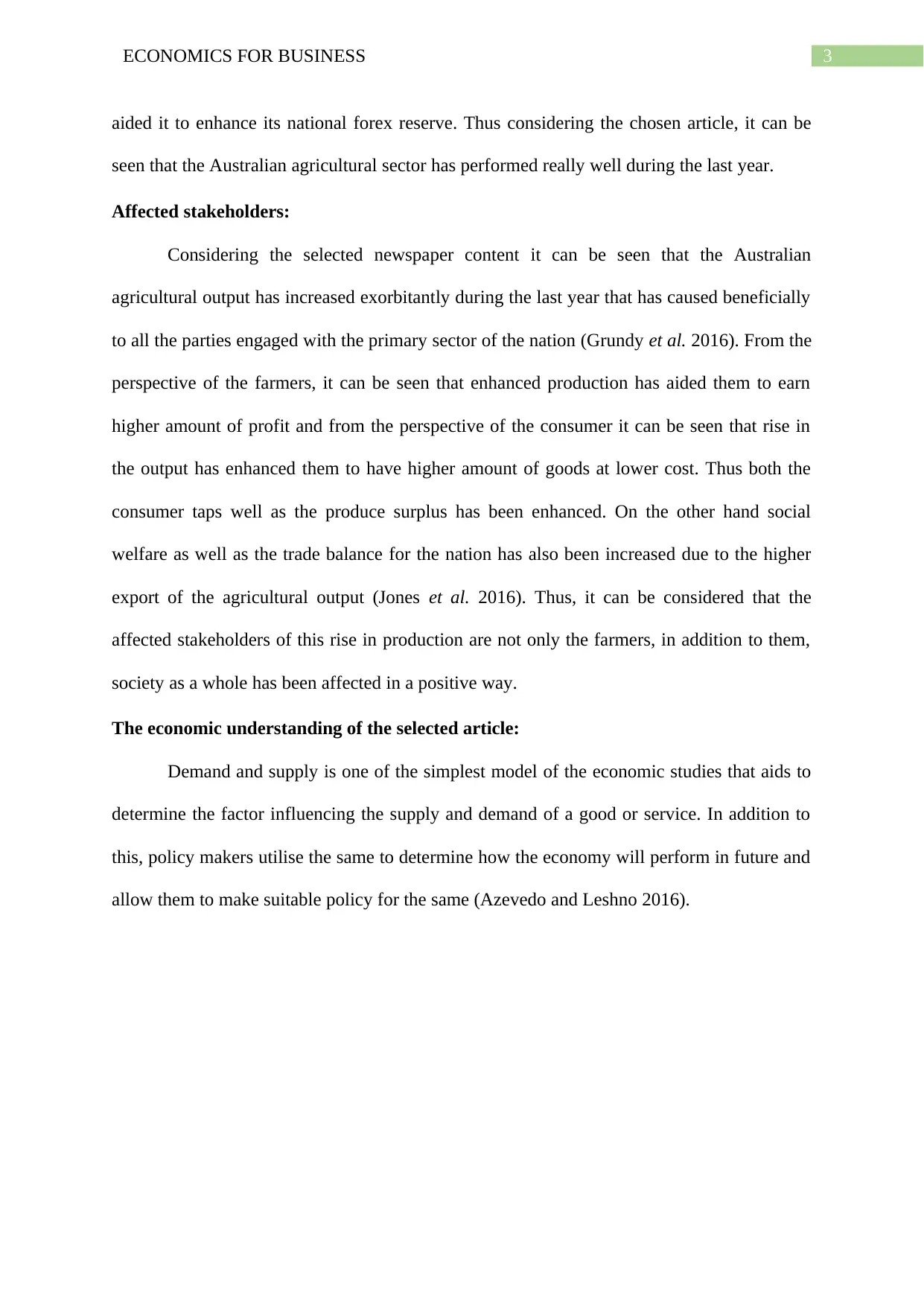
3ECONOMICS FOR BUSINESS
aided it to enhance its national forex reserve. Thus considering the chosen article, it can be
seen that the Australian agricultural sector has performed really well during the last year.
Affected stakeholders:
Considering the selected newspaper content it can be seen that the Australian
agricultural output has increased exorbitantly during the last year that has caused beneficially
to all the parties engaged with the primary sector of the nation (Grundy et al. 2016). From the
perspective of the farmers, it can be seen that enhanced production has aided them to earn
higher amount of profit and from the perspective of the consumer it can be seen that rise in
the output has enhanced them to have higher amount of goods at lower cost. Thus both the
consumer taps well as the produce surplus has been enhanced. On the other hand social
welfare as well as the trade balance for the nation has also been increased due to the higher
export of the agricultural output (Jones et al. 2016). Thus, it can be considered that the
affected stakeholders of this rise in production are not only the farmers, in addition to them,
society as a whole has been affected in a positive way.
The economic understanding of the selected article:
Demand and supply is one of the simplest model of the economic studies that aids to
determine the factor influencing the supply and demand of a good or service. In addition to
this, policy makers utilise the same to determine how the economy will perform in future and
allow them to make suitable policy for the same (Azevedo and Leshno 2016).
aided it to enhance its national forex reserve. Thus considering the chosen article, it can be
seen that the Australian agricultural sector has performed really well during the last year.
Affected stakeholders:
Considering the selected newspaper content it can be seen that the Australian
agricultural output has increased exorbitantly during the last year that has caused beneficially
to all the parties engaged with the primary sector of the nation (Grundy et al. 2016). From the
perspective of the farmers, it can be seen that enhanced production has aided them to earn
higher amount of profit and from the perspective of the consumer it can be seen that rise in
the output has enhanced them to have higher amount of goods at lower cost. Thus both the
consumer taps well as the produce surplus has been enhanced. On the other hand social
welfare as well as the trade balance for the nation has also been increased due to the higher
export of the agricultural output (Jones et al. 2016). Thus, it can be considered that the
affected stakeholders of this rise in production are not only the farmers, in addition to them,
society as a whole has been affected in a positive way.
The economic understanding of the selected article:
Demand and supply is one of the simplest model of the economic studies that aids to
determine the factor influencing the supply and demand of a good or service. In addition to
this, policy makers utilise the same to determine how the economy will perform in future and
allow them to make suitable policy for the same (Azevedo and Leshno 2016).
Paraphrase This Document
Need a fresh take? Get an instant paraphrase of this document with our AI Paraphraser
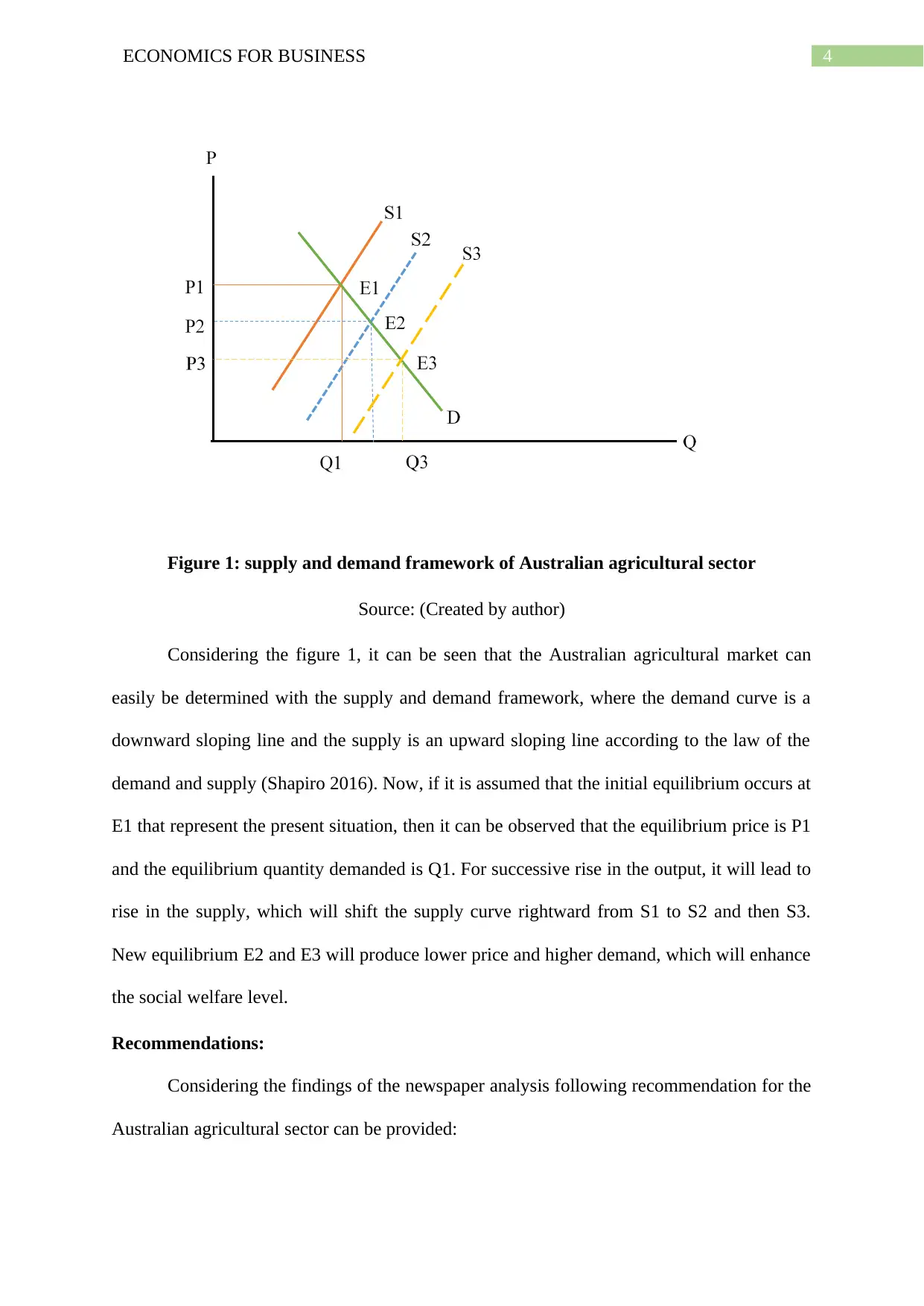
4ECONOMICS FOR BUSINESS
Figure 1: supply and demand framework of Australian agricultural sector
Source: (Created by author)
Considering the figure 1, it can be seen that the Australian agricultural market can
easily be determined with the supply and demand framework, where the demand curve is a
downward sloping line and the supply is an upward sloping line according to the law of the
demand and supply (Shapiro 2016). Now, if it is assumed that the initial equilibrium occurs at
E1 that represent the present situation, then it can be observed that the equilibrium price is P1
and the equilibrium quantity demanded is Q1. For successive rise in the output, it will lead to
rise in the supply, which will shift the supply curve rightward from S1 to S2 and then S3.
New equilibrium E2 and E3 will produce lower price and higher demand, which will enhance
the social welfare level.
Recommendations:
Considering the findings of the newspaper analysis following recommendation for the
Australian agricultural sector can be provided:
Figure 1: supply and demand framework of Australian agricultural sector
Source: (Created by author)
Considering the figure 1, it can be seen that the Australian agricultural market can
easily be determined with the supply and demand framework, where the demand curve is a
downward sloping line and the supply is an upward sloping line according to the law of the
demand and supply (Shapiro 2016). Now, if it is assumed that the initial equilibrium occurs at
E1 that represent the present situation, then it can be observed that the equilibrium price is P1
and the equilibrium quantity demanded is Q1. For successive rise in the output, it will lead to
rise in the supply, which will shift the supply curve rightward from S1 to S2 and then S3.
New equilibrium E2 and E3 will produce lower price and higher demand, which will enhance
the social welfare level.
Recommendations:
Considering the findings of the newspaper analysis following recommendation for the
Australian agricultural sector can be provided:
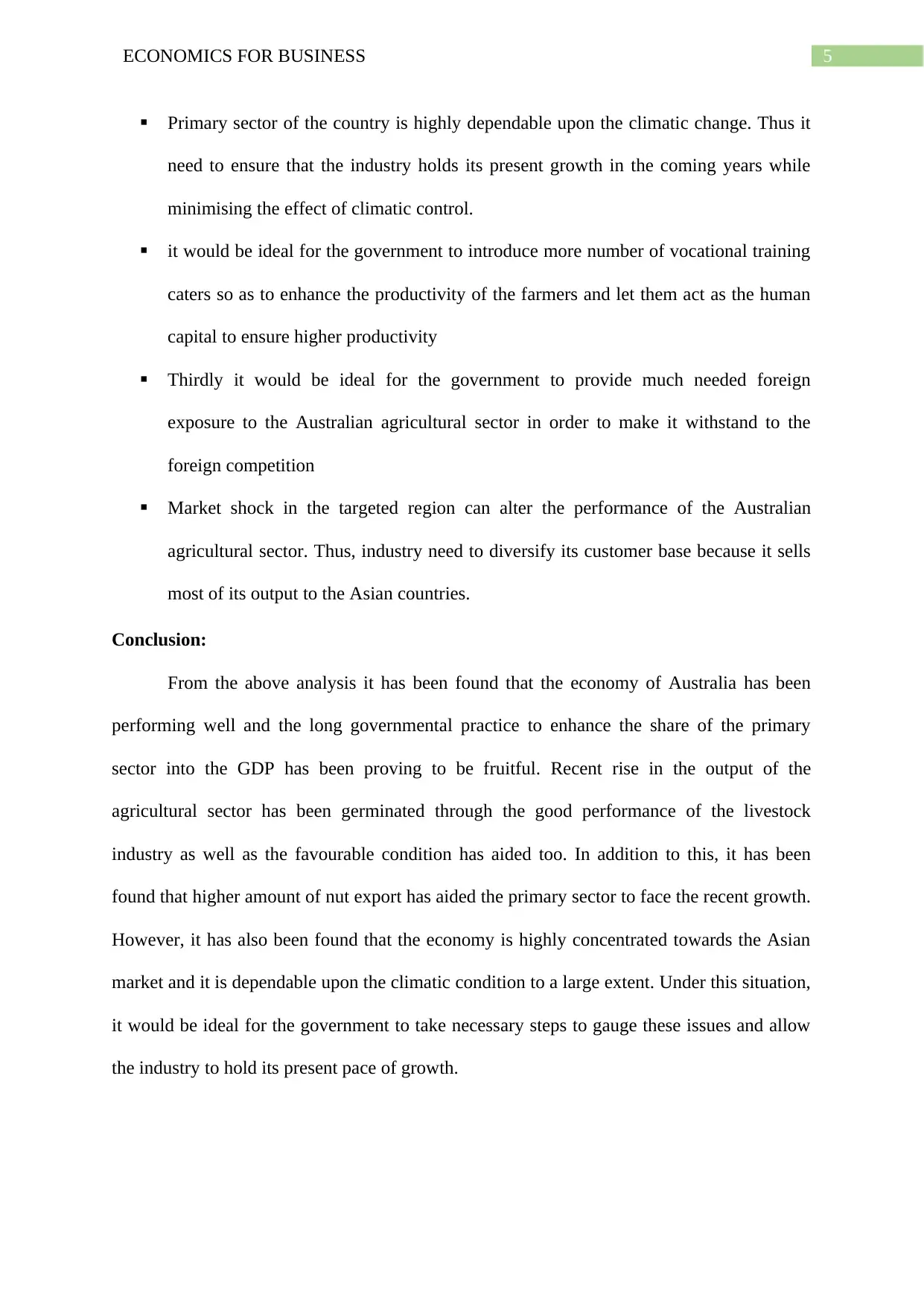
5ECONOMICS FOR BUSINESS
Primary sector of the country is highly dependable upon the climatic change. Thus it
need to ensure that the industry holds its present growth in the coming years while
minimising the effect of climatic control.
it would be ideal for the government to introduce more number of vocational training
caters so as to enhance the productivity of the farmers and let them act as the human
capital to ensure higher productivity
Thirdly it would be ideal for the government to provide much needed foreign
exposure to the Australian agricultural sector in order to make it withstand to the
foreign competition
Market shock in the targeted region can alter the performance of the Australian
agricultural sector. Thus, industry need to diversify its customer base because it sells
most of its output to the Asian countries.
Conclusion:
From the above analysis it has been found that the economy of Australia has been
performing well and the long governmental practice to enhance the share of the primary
sector into the GDP has been proving to be fruitful. Recent rise in the output of the
agricultural sector has been germinated through the good performance of the livestock
industry as well as the favourable condition has aided too. In addition to this, it has been
found that higher amount of nut export has aided the primary sector to face the recent growth.
However, it has also been found that the economy is highly concentrated towards the Asian
market and it is dependable upon the climatic condition to a large extent. Under this situation,
it would be ideal for the government to take necessary steps to gauge these issues and allow
the industry to hold its present pace of growth.
Primary sector of the country is highly dependable upon the climatic change. Thus it
need to ensure that the industry holds its present growth in the coming years while
minimising the effect of climatic control.
it would be ideal for the government to introduce more number of vocational training
caters so as to enhance the productivity of the farmers and let them act as the human
capital to ensure higher productivity
Thirdly it would be ideal for the government to provide much needed foreign
exposure to the Australian agricultural sector in order to make it withstand to the
foreign competition
Market shock in the targeted region can alter the performance of the Australian
agricultural sector. Thus, industry need to diversify its customer base because it sells
most of its output to the Asian countries.
Conclusion:
From the above analysis it has been found that the economy of Australia has been
performing well and the long governmental practice to enhance the share of the primary
sector into the GDP has been proving to be fruitful. Recent rise in the output of the
agricultural sector has been germinated through the good performance of the livestock
industry as well as the favourable condition has aided too. In addition to this, it has been
found that higher amount of nut export has aided the primary sector to face the recent growth.
However, it has also been found that the economy is highly concentrated towards the Asian
market and it is dependable upon the climatic condition to a large extent. Under this situation,
it would be ideal for the government to take necessary steps to gauge these issues and allow
the industry to hold its present pace of growth.
⊘ This is a preview!⊘
Do you want full access?
Subscribe today to unlock all pages.

Trusted by 1+ million students worldwide
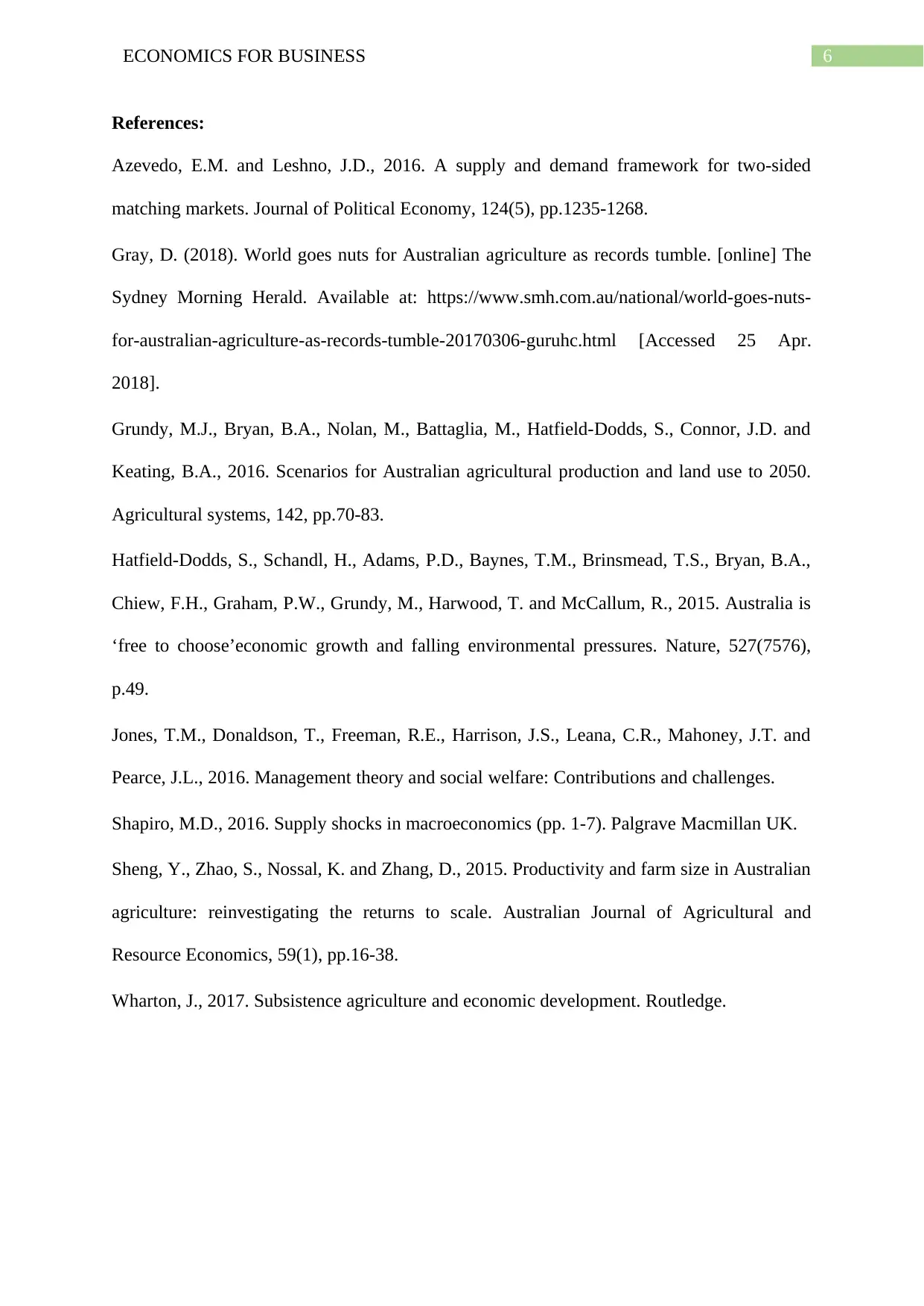
6ECONOMICS FOR BUSINESS
References:
Azevedo, E.M. and Leshno, J.D., 2016. A supply and demand framework for two-sided
matching markets. Journal of Political Economy, 124(5), pp.1235-1268.
Gray, D. (2018). World goes nuts for Australian agriculture as records tumble. [online] The
Sydney Morning Herald. Available at: https://www.smh.com.au/national/world-goes-nuts-
for-australian-agriculture-as-records-tumble-20170306-guruhc.html [Accessed 25 Apr.
2018].
Grundy, M.J., Bryan, B.A., Nolan, M., Battaglia, M., Hatfield-Dodds, S., Connor, J.D. and
Keating, B.A., 2016. Scenarios for Australian agricultural production and land use to 2050.
Agricultural systems, 142, pp.70-83.
Hatfield-Dodds, S., Schandl, H., Adams, P.D., Baynes, T.M., Brinsmead, T.S., Bryan, B.A.,
Chiew, F.H., Graham, P.W., Grundy, M., Harwood, T. and McCallum, R., 2015. Australia is
‘free to choose’economic growth and falling environmental pressures. Nature, 527(7576),
p.49.
Jones, T.M., Donaldson, T., Freeman, R.E., Harrison, J.S., Leana, C.R., Mahoney, J.T. and
Pearce, J.L., 2016. Management theory and social welfare: Contributions and challenges.
Shapiro, M.D., 2016. Supply shocks in macroeconomics (pp. 1-7). Palgrave Macmillan UK.
Sheng, Y., Zhao, S., Nossal, K. and Zhang, D., 2015. Productivity and farm size in Australian
agriculture: reinvestigating the returns to scale. Australian Journal of Agricultural and
Resource Economics, 59(1), pp.16-38.
Wharton, J., 2017. Subsistence agriculture and economic development. Routledge.
References:
Azevedo, E.M. and Leshno, J.D., 2016. A supply and demand framework for two-sided
matching markets. Journal of Political Economy, 124(5), pp.1235-1268.
Gray, D. (2018). World goes nuts for Australian agriculture as records tumble. [online] The
Sydney Morning Herald. Available at: https://www.smh.com.au/national/world-goes-nuts-
for-australian-agriculture-as-records-tumble-20170306-guruhc.html [Accessed 25 Apr.
2018].
Grundy, M.J., Bryan, B.A., Nolan, M., Battaglia, M., Hatfield-Dodds, S., Connor, J.D. and
Keating, B.A., 2016. Scenarios for Australian agricultural production and land use to 2050.
Agricultural systems, 142, pp.70-83.
Hatfield-Dodds, S., Schandl, H., Adams, P.D., Baynes, T.M., Brinsmead, T.S., Bryan, B.A.,
Chiew, F.H., Graham, P.W., Grundy, M., Harwood, T. and McCallum, R., 2015. Australia is
‘free to choose’economic growth and falling environmental pressures. Nature, 527(7576),
p.49.
Jones, T.M., Donaldson, T., Freeman, R.E., Harrison, J.S., Leana, C.R., Mahoney, J.T. and
Pearce, J.L., 2016. Management theory and social welfare: Contributions and challenges.
Shapiro, M.D., 2016. Supply shocks in macroeconomics (pp. 1-7). Palgrave Macmillan UK.
Sheng, Y., Zhao, S., Nossal, K. and Zhang, D., 2015. Productivity and farm size in Australian
agriculture: reinvestigating the returns to scale. Australian Journal of Agricultural and
Resource Economics, 59(1), pp.16-38.
Wharton, J., 2017. Subsistence agriculture and economic development. Routledge.
1 out of 7
Related Documents
Your All-in-One AI-Powered Toolkit for Academic Success.
+13062052269
info@desklib.com
Available 24*7 on WhatsApp / Email
![[object Object]](/_next/static/media/star-bottom.7253800d.svg)
Unlock your academic potential
Copyright © 2020–2026 A2Z Services. All Rights Reserved. Developed and managed by ZUCOL.




